Dude! Take Your Turn!
A Gaming Life
Review – Time of Crisis
(Edit: This is one of my Top 5 Games Played of all Time, as of February 2019 anyway. Check out the other games as well!)
Ever since my college toga parties, I’ve wanted to be a Roman emperor. I mean, sure, they had a tendency to die in horrible ways, many of them were cruel and corrupt and it all together wasn’t a good time for them.
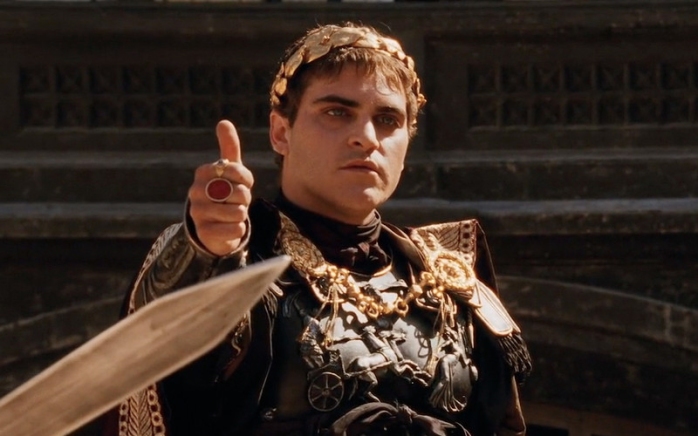
But just think of the perks! There are people peeling your grapes! Throwing flowers in front of you as you walk! There are…
Ok, maybe it wouldn’t have been so great. But I looked good in a toga. (Editor: “Looked” being the operative word)
Why am I talking about all of this?

Because I am finally able to do a review of one my favourite (Editor: Spoilers!!!) games out there, Time of Crisis, published by GMT Games.
The game was designed by Wray Ferrell and Brad Johnson with art by Rodger B. MacGowan and it plays 2-4 players in 2-3 hours.
Let’s see how this works.
How to Play
(This is just going to be a general overview, as a detailed explanation would probably be longer than you’re willing to read. I suggest watching a good playthrough, like Heavy Cardboard’s).
In Time of Crisis, you are a noble family during this tumultuous time in the Empire. In the years 235 – 284 AD, there were something like 50 emperors in those 50 years (maybe there were only 49 or something, but suffice it to say that if you became Emperor in this period, your life expectancy was considered quite short).
You are basically trying to form the political power to install one of your family members (probably one you don’t like) as Emperor by influencing the Senate to vote for you. You do this by installing your other family members as governors of various provinces around the empire, thus weakening the current Emperor and making him ripe for the picking.
What does this mean?
Let’s take a look at an actual turn and how the map works.

You can see the map of the Empire there, with a bunch of different provinces and their support levels (the numbers underneath the square box indicating the capital).
During set up, each player will choose a province to start in, placing their At Start governor on the “1” space of the support level and their At Start general along with a legion and a militia in the capital. All other provinces will have a neutral governor.
Whoever governs Italy (Italia) is the Emperor, and the support level there begins at the number of provinces that player controls. At the beginning of the game, the “neutral” player will have a support level that depends on the number of players. For 2 and 3-player games, some provinces are not in play (i.e. will never have governors) and thus the starting support for Italia will be lower.

Barbarians are placed in their respective areas just outside the Empire, waiting to pounce. They begin with their Inactive side up.
Then the game begins.
The first thing (other than upkeep, removing upkeep counters from their last turn) a player does on their turn is roll 2d6 and checking the Crisis Table.
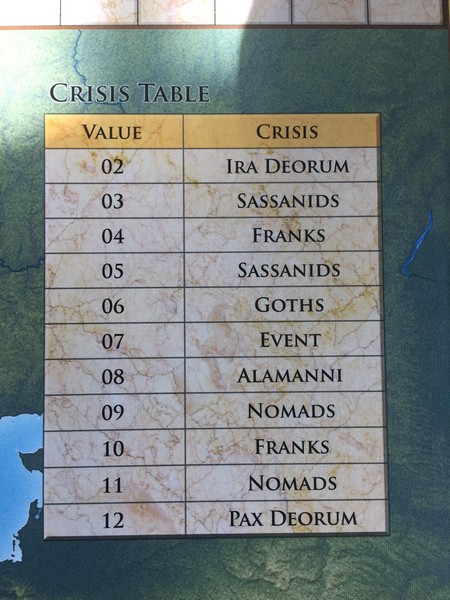
This table determines which barbarian tribe has a new unit activate, or maybe a random event card will be drawn (which can bring bad omens, good omens, maybe a rival Emperor or Barbarian Leader to liven up the party).
Once the crisis has been established (perhaps barbarian tribes rampaged over the border!), the player plays their cards.
You do this through a deck-building mechanic that I actually really love.
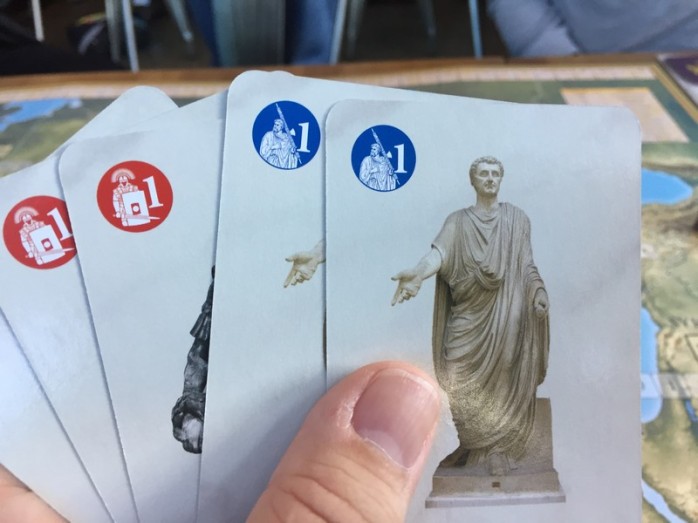
You start with a deck of 9 starter cards, three yellow (populace), three blue (Senate), and three red (military). While you will be “buying” more cards with your support points, you will never shuffle your deck. You will have 5 cards in your hand.
You play these five cards and earn the points in the top left corner. These will give you points to use to do Military, Senate, or Populace actions. The cards you buy have abilities on them, and those can be used on your turn as well if you wish (it’s not an “either/or” thing, you get the points regardless of whether you use the ability).
Military actions let you recruit generals, add legions to existing armies, create an army (with an already recruited general), move an army, or initiate battle with either barbarians or another player’s army in the same province.
Senate actions are where you recruit your governors (“Boberius! You’re up next! Get a move on!”) and then attempt to place recruited governors to take control of provinces (“But Mother! I don’t want to govern Pannonia! I want to play the lyre!”). You can also recall governors as well (“Boberius was always a disappointment to me.”)

Populace actions will let you increase the support level in provinces you govern, place militia in a province you govern that doesn’t already have one, hold games to calm the unruly mobs, and build improvements that will gain you legacy and also have other nice benefits.
Once you’ve played your cards, fought all of the fights you’re going to do, installed your wretched nephews as governor in some wayward province, or maybe even installed your son as new Emperor, you check for support issues. The regular people in your provinces don’t like active barbarians running around the countryside and they tend to blame the governor (who is probably too busy playing the lyre to deal with them) so support falls in provinces where this is happening.
They also don’t like it when some other family installs its army in the capital. They start to get nervous when that happens. And they blame the governor for that too (really, governors can’t win). Support falls.
The same is done if there is a rival emperor in their province.
If support drops to zero, then the governor is run out of the capital and somebody neutral takes their place.
Next, you check to see if your Pretender Empire expands at all. What’s this? Yes, if you can’t take over Italy and you have the right conditions and card (4-strength Yellow card), you can form a Pretender Empire in some farflung province. This will get you points and will cause a big headache for the goon who’s actually in Italy. Romans don’t like it when people elsewhere declare themselves emperor.
And yes, like always, they blame the current emperor for that too. Italia support level falls (actually that happens in the previous phase).
In this current phase, you’re checking to see if any of your other provinces will join your Pretend Empire.
Next, you gain legacy points for each province you own, each improvement in a province you own, and then also additional legacy for your support level in Italia (or your Pretender Empire, or maybe both?). Being Emperor can be quite lucrative. But you paint a target on your head.

Finally, you can buy new cards to add to your deck. The cost and which ones you can get depend on how many provinces you have and the amount of support in them.
At the end of your turn, you discard the played cards and then do something that I’ve never seen in a deck builder, and which I really love.
YOU CHOOSE YOUR NEXT HAND OF FIVE CARDS!!!!
None of this random stuff. As long as the card is in your available pile, you can pick it. You decide what you want to do next turn, and then you take the cards that will help you do it.
The only catch here is that once a card is discarded, it’s not able to be chosen until all of your available cards are gone. So you can really stack your hand one turn, able to do a lot, but then next turn you may only have weak starting cards left in your deck.
So you do have to plan things accordingly.
That’s your turn in a nutshell. Throughout the game, fortunes will ebb and flow. You may be flooded with barbarians and not able to do much politically, but dealing with barbarians gives you points as well. Or you could install your son as Emperor and then fight off all comers.
Once somebody reaches 60 legacy points (or 40 in the learning game, which I don’t recommend other than your first game, and even that’s debatable) and is Emperor, that triggers the end game. Players get an equal number of turns, and then the game ends.
Whoever was Emperor longest gets 10 points, second-longest gets 6, third-longest 3 and fourth-longest gets zero (and the derision of the populace).
Whoever has the most Legacy is the winner!
Is Time of Crisis the reign of Marcus Aurelius or the reign of Caligula?
There’s a reason that Time of Crisis was my #1 game played in 2017. It is a brilliant design, evocative of the era, with a nice mix of mechanics between deck-building, wargame and politics.
Let’s talk about the components first.
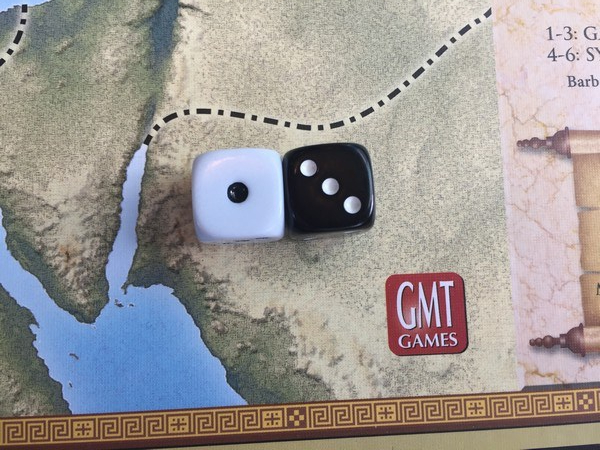
The game comes with three black and three white 6-sided dice. This is important because of the crisis checks, where the black die determines whether or not barbarians invade and the white die determines where they invade if they do. It also becomes helpful if you are rolling in combat for multiple types of units. You can say “Militia is the black die, Legion is the white die.”
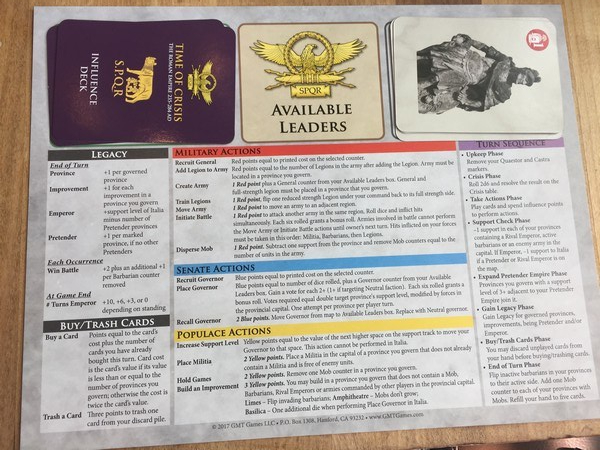
The player sheets are so wonderfully made. I can’t think of anything they don’t have on them. It tells you each possible action and how much it costs, a detailed turn sequence that if you follow, you will never forget anything, what you get Legacy points for, how to buy/trash cards, and it gives you a space for your recruited leaders and your available/discard pile for your cards.
I bow down to Wray and Brad, whichever one designed it (or if that part was delegated, then whomever at GMT Games did it).

The counters are already clipped, so no need to spend time doing that. The corners are rounded.
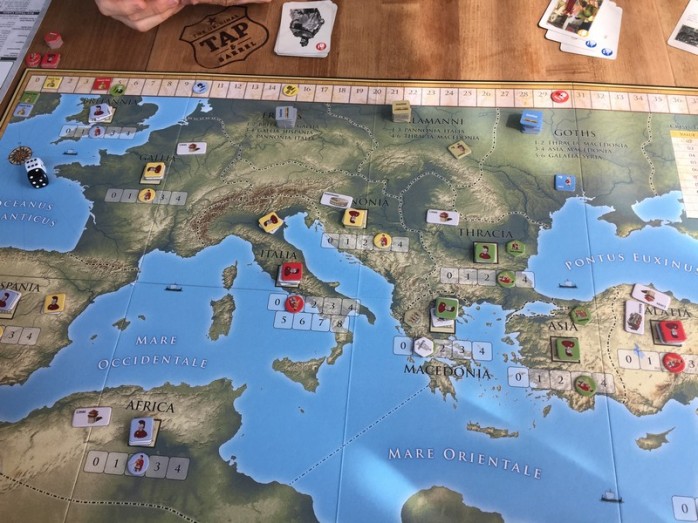
The map is beautifully illustrated, with a bunch of handy items as well. The art on the cards is very nice too too. The counter art is great and very clear and easy to read. I’d say the artwork is stellar
How does the game play?
The only major fault I would give Time of Crisis, and really this could be said about a lot of games, is that the opening is fairly scripted.
You have 9 cards to choose from, and it’s pretty important to go after neutral provinces quickly, so you’re almost always going to take either 3 blue and 2 red cards or vice versa and then take over a province on your first turn.
There may be others, and maybe expert players would dispute that, but it does seem like you don’t have a lot of options to start with.
That will change as the game goes on, as event cards come up and barbarians start threatening and as you build your deck.
After the first couple of turns, though, the game gets riveting. There are so many choices and you have to decide what area you’re going to concentrate on. Are you going to favour a military policy or a political one? Or go heavy on populace actions? You do need to spread things out a little (you can’t install governors without blue cards), but if you spread too thin, you won’t be able to do anything.
The event cards really add some spice.

Things can get looking really bad if a rival Emperor or Barbarian leader show up. Or if Barbarians start massing with the above event.
I like that there is some randomness in the game, but it can be mitigated somewhat by events and other things like that. In combat, legions hit on a 3+, while barbarians hit on a 4+ and militia/wounded legions hit on a 5+. Thus, better quality troops are generally going to fare better in battle.
But not always (Editor: They don’t call you King Snake-eyes for nothing).
One other minor issue, which is due to bad luck mainly, is the last player can get a little screwed.
First, the player gets last choice of which province to start in, which means inevitably they’re going to be next to barbarians (there are only two provinces that you can choose that don’t start next to them anyway).
Secondly, if you’re last in a 3 or 4 player game, you’ve had two or three turns to have bad things happen to you. In one 3-player game I played, the player started in Syria (probably not the smartest move, but without knowledge of possible events, he didn’t know any better and I wasn’t familiar enough with the game to warn him). I started, rolled so that one Sassanid barbarian was activated, then rolled a 1 to have that barbarian move. It happened to go into Syria.
Second player rolled a 7, which is an event card. Sure enough, the Rival Emperor that shows up in Syria was drawn. Now he had a barbarian *and* a Rival Emperor in his home province. Without having any resources to deal with this.
Thankfully, it is possible to come back from this, as he only came in third place by a few points. But it really puts you off to a bad start, through no fault of your own. And if you’re playing competent opponents, you could really be left in the dust.
With only those two negatives, though, I have to say that Time of Crisis is one of the best games I’ve played for sheer entertainment value. It helps that I’m a history buff anyway, so if you don’t like history or player conflict, this game isn’t for you. You have to go after the other players, especially when one becomes Emperor.

This game is not for peaceniks.
I find this game has a great combination of skill and luck that makes it a fun game for anybody who doesn’t mind a little luck. There are dice, there are event cards, and as shown above, you could get screwed.
The trick is how you go about dealing with that luck. That’s what I think is the best thing about this game.
Time of Crisis is a highly recommended game. I’ve managed to get it to the table four times since I bought it last Fall, which doesn’t happen for me with games that can take this long (3-hour games don’t get played often). That shows how much I really enjoy it.
It works wonderfully at three players or four (for three players, you basically eliminate Spain (Hispania), Africa, and Egypt (Aegyptus) from play, and there are no Nomads).
The game does also play with two players, but I haven’t tried that yet. More barbarians and provinces are removed, and it just doesn’t sound as fun. But that is not a statement made with any experience, so take it for what it is.
If you get a chance to play this and don’t mind dice in your games, you should definitely give Time of Crisis a try.
But I have to ask, GMT Games, what is with the unicorn sea monster off the coast of Spain?

(This review was written after 4 plays)
Pingback: Book Review – How Rome Fell by Adrian Goldsworthy – Dude! Take Your Turn!
That was a very entertaining review. Glad you enjoyed the game. Look forward to reading your thoughts about the expansion.
LikeLiked by 1 person
Wow, thank you Wray!!! I really appreciate the comment, and I’m glad it was entertaining. I’m one of those bloggers who thinks that reviews should be more than just “this is good, this is bad,” but have some entertainment value as well.
I am super-excited about the expansion (I did do a post about it reaching the 500 level, but I forgot to link to it!). I was one of the first hundred or two hundred to sign up for it.
LikeLike
Pingback: Flashpoint South China Sea – Let’s Get This Produced! – Dude! Take Your Turn!
Pingback: Top 10 Games Played in 2017 (5-1) – Dude! Take Your Turn!
Pingback: New to Me – October 2017 – Dude! Take Your Turn!
Pingback: Top 25 Games Played of All Time (5-1) – Dude! Take Your Turn!
This is such an exciting, simple and enjoyable game…
LikeLiked by 1 person
Pingback: Harold Buchanan Interviews Gene Billingsley from GMT Games – Dude! Take Your Turn!
Pingback: New to Me – June 2019 – Dude! Take Your Turn!
Pingback: The Barracks Emperors from GMT Games – Dude! Take Your Turn!
Pingback: Top 10 Games Played in 2019 (5-1) – Dude! Take Your Turn!
Pingback: 4 Years and Counting – Dude! Take Your Turn!
Pingback: October 2021 Monthly Update from GMT Games – Dude! Take Your Turn!
Pingback: Top 25 Games Played of All Time – 2022 Edition (#5-1) – Dude! Take Your Turn!
Pingback: Time of Crisis – Storage Solution from Rails on Board – Dude! Take Your Turn!
Pingback: Highlights From the January 2023 GMT Games Update – Dude! Take Your Turn!
Pingback: New to Me – January 2023 – Dude! Take Your Turn!
Pingback: Time of Crisis from GMT Getting a Deluxe Edition & Mini-Expansion – Dude! Take Your Turn!
Pingback: September 2023 Gaming – Dude! Take Your Turn!
Pingback: Highlights From the October GMT Games Update – Dude! Take Your Turn!
Pingback: Friday Night Shots – Trick Taking Games – Dude! Take Your Turn!
Pingback: Blog in Review – 2023 – Dude! Take Your Turn!
Pingback: Top 50 Games Played of All Time – 2024 Edition (#10 – 1) – Dude! Take Your Turn!
Pingback: Friday Night Shots – Player Count – Dude! Take Your Turn!